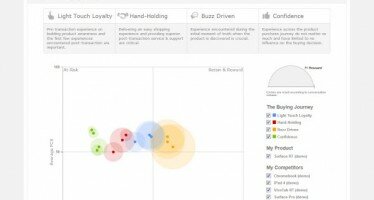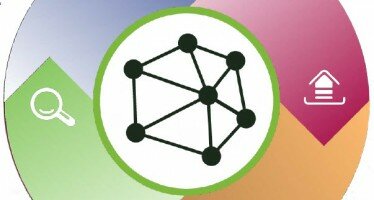Oracle Announces New Data Cloud: Data as a Service for Marketing, Social, Sales

In February of this 2014, Oracle acquired BlueKai, a cloud-based data management platform and integrated it with its B2C (Responsys) and B2B (Eloqua) marketing automation platforms to provide better personalized experiences. Today, Oracle announced that, BlueKai’s Audience Data Marketplace (one of the biggest data market exchanges available today) is combined with data from other software services to create a new business line: Data as a Service (DaaS).
I talked about the new service with Omar Tawakol, Group VP and General Manager of the Oracle Data Cloud.
Originally, the BlueKai exchange contained commerce data, but they opened it to include many new types of data including classic data assets from the offline world (transaction data, comScore, Experian, Axiom, Nielsen and the list goes on). All these companies would put their data in the exchange with BlueKai simply being the NASDAQ of the Exchange. A few years later, Tawakol said they started to license their software to the Fortune 100 to manage their data, use it to make their own ads more effective.
Then Oracle acquired it, and Ellison encouraged the BlueKai team to think beyond data for marketing and find other applications. Oracle had other applications that stored various kinds of data, so together all this data now makes up the new Oracle Data Cloud.
Solving Business Problems with DaaS
Tawakol outlined several business problems that this new data as a service for business is going to help solve.
- Marketing – this area we are very familiar with and one that many customer experience/digital experience vendors are trying to solve. Who are your best customers, what do they look like, who similar is a close prospect? You need data about your customers and what they are doing to provide this information.
- Sales and sales opp – You want to make sure you are contacting the right person in an organization, that you have the right contact information for that person and you know things like their social handle for more insights, etc.. This helps increase pipeline conversion rates.
- Service – Who are your best customers and how do they influence others and who do they influence. They also can use social media to get a better handle on what people are saying about their products/services.
What do these business problems have in common? They need data, and lots of it. But, as Tawakol pointed out – we have data connectivity challenges:
- There’s often no common identifier so you can link data attributes between systems.
- It’s not easy to get data into platforms that use it, especially when we’re talking about external apps (which we often are) where there is no integration. A typical marketers might use a couple dozen different
- We have the privacy/legal regime to consider with all these different types of data.
Enter Data as a Service for Business
DaaS is a data licensing model where data is provided through a cloud service for applications and business users using those applications. It is vendor agnostic, so you don’t need to use this data with only Oracle solutions. Tawakol likens it to the database systems that Oracle sells.
They have a leadership position, said Tawakol, that they want to maintain, and the best way to do that is to make the data accessible to everyone, keep it as open as possible. Oracle sees the data as a service category as a larger fast emerging category and it’s much more valuable to the end user because they can use it for all of their applications.
BlueKai had that “swiss model” from the start. This model resulted in their exchange being integrated into hundreds of media and digital marketing applications, and with their APIs, they can integrate with additional software vendors.
The other key point that Tawakol made when we spoke was that DaaS is not just meant for marketers. It’s designed to get data into the full enterprise, from marketing to sales to service and more. The exchange takes in about a billion profiles a month with an average of 50 attributes each.
To do that, Tawakol described a pipeline approach where:
- Getting the Data – Data is imported into the service from hundreds of providers/services, structured, unstructured, anonymous, PPI, offline, online, mobile, video, search and social.
- Value Extraction – getting meaning from the data and separating the signal from the noise. You see things here such as taxonomies, analytics, look a like models, semantic analysis and more.
- Rights management – who has what rights to use what data and through what channels and price? Also take care of all the privacy/legal issues.
- Data activation – plug the data into the end system you want to use. This is not for IT use, it’s designed for business users, who can go directly into the apps they use and have the data accessible to them.
Let’s give you an example of how this works:
You can into the data as a service application and configure your data assets. Then you configure where you want to use the data and the system will let you know that certain data assets are usable or aren’t in the application you select. Once that’s done, the data is provisioned to the application (this integration remember is all done before hand with the application vendor). You then go into your application and the data is automatically available to you to start using.
Breaking the service down a bit further:
Data as a Service for Marketers
There are many marketing platforms integrated with the new Oracle Data Cloud, in addition to all the data providers who feed the data into the service itself. Marketers can use this service to get a better handle on customers and prospects and feel relevant ads and content across mobile, search, social, video and websites. This was, Tawakol said, what BlueKai originally was designed to do, now it does it even better.
Data as a Service for Social
Consider that there are 700 million messages a day, maybe even 400 million in a peak hour from over 40 million sites across social, video, blogging and other public sites. This service enables you to extract themes, topics that are most popular, get a feel for how customers/prospects feel about the brand. It can even take data out of chat logs to mine internal data assets.
Tawakol said these services have been available through the Oracle Social Cloud, but now you don’t need to get the SRM stack to get access to this data and use it in non-Oracle applications.
A Common Understanding of the Customer
Getting a full view of the customer is challenging, if not impossible these days. Data is very fragmented across everything a user does: social handles, email address, phone numbers, etc. Over the last few years a new technique emerged that allows email marketers to connect emails to cookies that enable them to serve more targeted advertising (it’s called un-anonymization).
Oracle has built an identity map that connects cookies to emails, cookies on devices to identifier on mobile, social handles to email, connecting every direction. Oracle’s acquisitions with email, social has enabled them to connect all this information together to get that common understanding of the customer.
Tawakol says other companies are doing this, but are pushing their own unique identifier (Google, Apple being two of the big names that also do it). The difference is that Oracle isn’t forcing a unique identifier, they want to simply create a map that enables to you pull everything together based on the identifier you chose.
There are two different licensing models for the Oracle Data Cloud:
- Pay Per Use – You can pay on a per impression basis.
- Subscription Model – There are monthly subscription rates based on volume and variety.
You can read more of Tawakol’s thoughts on DaaS in this Forbes Brand Voice article, or head over to Oracle and get more information there. The DaaS framework is available now as are DaaS for Marketing and DaaS for Social specific services. More standalone offerings will be coming including ones for Sales Opp and Service.
Share and Enjoy
Related Articles
SDL Launches New Versions of Social and Campaigns, Both with New User Experiences
Not to be out done today by Adobe’s big announcements, SDL has introduced a couple of its own we thought
Share and Enjoy
Hippo Takes an Intelligent View of Web Content Management
Hippo is not gearing up its own Marketing Cloud. Instead, the Amsterdam based WCM vendor, is focusing its attention on
Share and Enjoy
Adobe Social Goes More Global, Including Publishing to China’s Sina Weibo Social Network
Global organization’s need global social publishing tools and Adobe is making sure it meet those needs with its Fall Update.





